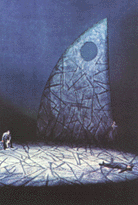Daylight Simulation: Validation, Sky Models and Daylight Coefficients
PhD Thesis, De Montfort University, 2000
 “Das licht! Das licht!”
“Das licht! Das licht!”
Abstract
The application of lighting simulation techniques for daylight illuminance modelling in architectural spaces is described in this thesis. The prediction tool used for all the work described here is the Radiance lighting simulation system. An overview of the features and capabilities of the Radiance system is presented. Daylight simulation using the Radiance system is described in some detail. The relation between physical quantities and the lighting simulation parameters is made clear in a series of progressively more complex examples. Effective use of the inter-reflection calculation is described.
The illuminance calculation is validated under real sky conditions for a full-size office space. The simulation model used sky luminance patterns that were based directly on measurements. Internal illuminance predictions are compared with measurements for 754 skies that cover a wide range of naturally occurring conditions. The processing of the sky luminance measurements for the lighting simulation is described. The accuracy of the illuminance predictions is shown to be, in the main, comparable with the accuracy of the model input data. There were a number of predictions with low accuracy. Evidence is presented to show that these result from imprecision in the model specification - such as, uncertainty of the circumsolar luminance - rather than the prediction algorithms themselves. Procedures to visualise and reduce illuminance and lighting-related data are presented.
The ability of sky models to reproduce measured sky luminance patterns for the purpose of predicting internal illuminance is investigated. Four sky models and two sky models blends are assessed. Predictions of internal illuminance using sky models/blends are compared against those using measured sky luminance patterns. The sky model blends and the Perez All-weather model are shown to perform comparably well. Illuminance predictions using measured skies however were invariably better than those using sky models/blends.
Several formulations of the daylight coefficient approach for predicting time varying illuminances are presented. Radiance is used to predict the daylight coefficients from which internal illuminances are derived. The form and magnitude of the daylight coefficients are related to the scene geometry and the discretisation scheme. Internal illuminances are derived for four daylight coefficient formulations based on the measured luminance patterns for the 754 skies. For the best of the formulations, the accuracy of the daylight coefficient derived illuminances is shown to be comparable to that using the standard Radiance calculation method.
The use of the daylight coefficient approach to both accurately and efficiently predict hourly internal daylight illuminance levels for an entire year is described. Daylight coefficients are invariant to building orientation for a fixed building configuration. This property of daylight coefficients is exploited to yield hourly internal illuminances for a full year as a function of building orientation. Visual data analysis techniques are used to display and process the massive number of derived illuminances.
Daylight Simulation: Validation, Sky Models and Daylight Coefficients [Complete thesis PDF 20Mb]
Chapter 2 originally appeared in Rendering with Radiance: The Art and Science of Lighting Visualization. It was reproduced in the thesis with permission.
